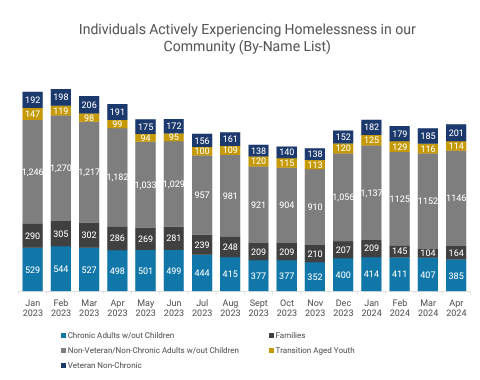The Community Homelessness Advisory Board (CHAB) met today for its first meeting of 2024. The board members discussed the brief hiatus in meeting as many objectives of the previous board have been enacted, but informally agreed that more frequent meetings will be necessary as the next phases of the Nevada Cares Campus come online and the community turns its attention to housing. The following is the top news from the meeting:
1. Emergency overflow shelter space to close: Washoe County will close the 84-bed emergency overflow shelter adjacent to the Resource Center as the harsh winter weather has passed and the county has identified 140 beds in the region that are not being fully utilized. Over the course of a two-week phased closure, participants in the overflow shelter will be moved to other shelters including the Cares and Our Place campuses. The Resource Center is also used for a cooling center in the summer, and staff will continue to monitor the need for shelter.
“Each year winter overflow beds are usually closed down on April 1st. This year we saw people continue to use the overflow in April, but we also saw other beds opening up because the weather was getting warmer,” Division Director of Housing and Homeless Services Dana Searcy said. “Anyone utilizing overflow beds, we are connecting with staff to offer other options, whether that be inside the campus or elsewhere across the community. Anyone who lets us know they would like to stay at the campus, we will find a place at the campus.”
 2. PIT Count and homelessness data explained: Much has been said about the recently released Point in Time (PIT) Count numbers that showed a marginal increase in January 2024 over January 2023. Searcy walked the CHAB members through the data that includes PIT Count and the Actively Homeless Count (By Name List) with the Homelessness Management Information System (HMIS).
2. PIT Count and homelessness data explained: Much has been said about the recently released Point in Time (PIT) Count numbers that showed a marginal increase in January 2024 over January 2023. Searcy walked the CHAB members through the data that includes PIT Count and the Actively Homeless Count (By Name List) with the Homelessness Management Information System (HMIS).
The PIT Count is conducted on a single day each January as required by the U.S. Department of Housing and Urban Development (HUD). It counts all people experiencing homelessness either sheltered or unsheltered. With the opening of the Nevada Cares Campus, the number of those unsheltered – living on streets or benches or otherwise in the open – has been dramatically cut, from 780 in 2021 to 363 this year and that 53% reduction in unsheltered was the focus of a national publication last year.
The data in HMIS provides a real-time, dynamic and comprehensive list of people experiencing homelessness. It is reported monthly and shows a rolling 90-day number using Built for Zero methodology. With this data, the organizations that work with the homeless population can cooperatively triage the needs of individuals without the wasted effort of overlapping resources. This is also called the “by-name” list because it is exactly that: a list of named individuals and their needs.
“It also allows us to see information down to the person level,” Searcy said. “Each person is a unique person with unique needs and this allows us to offer a tailored approach.”
It was only in the fall of 2023 that the region achieved “quality data,” meaning that 94 percent of the 27 agencies and 60-plus programs that interact with the homeless population are now using HMIS. Before that time, the utilization of HMIS was around 40 percent.
3. COVID Emergency Rental Assistance program ends: Washoe County received approximately $6.1 million from the federal government to combat COVID- and recession-related evictions. The program has ended, and Washoe County is completing the allocations of these funds.
The Washoe County Board of County Commissioners approved approximately $2 million for the Affordable Housing Trust Fund, and two projects will be brought forward for approval soon, one of which is dedicated to the senior population, and both projects are serving low-income people.
4. Community Needs Assessment completed: The Corporation for Supportive Housing (CSH) was contracted by Washoe County to assess the current needs of the community, and worked with local government entities as well as local nonprofit organizations such as The Salvation Army, Safe Embrace, Awaken Reno, Faith in Action, and more.
Brooke Page, director of the Corporation for Supportive Housing, presented the Community Needs Assessment, which concluded that regionally, the Cities of Reno and Sparks and Washoe County need to build 652 affordable homes, fund operating and rental subsidies for 3,184 households, provide supportive services for 1,305 households experiencing homelessness, and address racial disparities for the BIPOC populations that are over-represented in the homelessness system.
“We have an affordability issue, and we can’t talk about addressing housing if we also aren’t talking about the rise in the cost of how expensive it is to live in this community,” Page said, adding that among the root causes of homelessness is stagnant wages. “If we’re not seeing wages keep up with the pace of inflation, we’re going to see people falling into homelessness.”
Watch the full meeting here.

